Human Flower Project
Ready, Aim, Bloom
Allen Bush shuttles between battle fantasies, old and new, as April in the Ohio Valley loads and fires its botanical best.
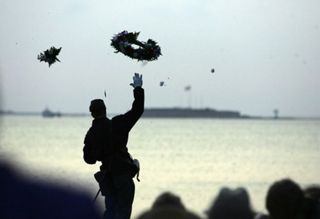
Ernest Parks, re-enactor from Company I, Massachusetts 54th Regiment, tosses a wreath into Charleston (SC) Harbor toward Fort Sumter, April 12, 2011.
Photo: The Reenactors
By Allen Bush
My eyes were blood shot from tree pollen and gun smoke after a volley of blossoms and bullets. The April signal corps of redbuds, dogwoods and paw paws was flanked to the north by Civil War reenactors in Corydon, Indiana, and to the south by the Knob Creek Machine Gun Shoot near West Point, Kentucky. The reenactors understood the sorrow of war. The belligerent infidels at Knob Creek were locked and loaded. The magnificence of spring surrounded them all.
April 12, 2011 was the 150th anniversary of the Confederate firing on Fort Sumter in Charleston, South Carolina, in 1861. (Major Robert Anderson, a native of Louisville, Kentucky refused to surrender the Federal fort.) Lincoln feared this provocation for Civil War.
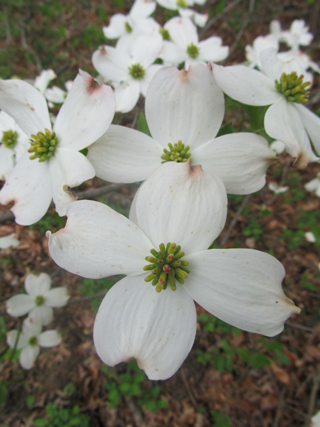 Cornus florida: dogwood
Cornus florida: dogwood
Photo : Allen Bush
The Confederacy’s secretary of state Robert Toombs warned President Jefferson Davis against the dire consequences of a Fort Sumter bombardment: “The firing on that fort will inaugurate a civil war greater than any the world has yet seen … You will lose us every friend in the North. You will wantonly strike a hornet’s nest, which extends from mountains to ocean.” President Davis paid little mind. The war was on in orchards, gardens, farm fields and woodlands for the next four years.
In his novel The Souls of Wind, John Olson describes Jack Jaffe, who’d lost his arm at the battle of Shiloh (Tennessee) in early April 1862. “He’d remembered the incident vividly: peach petals raining down like snow as they were clipped by the bullets tearing through. It made a very pretty picture until the ground became soaked with blood.”
Up north, the 35th Ohio Volunteer Infantry Company G had enlisted nine hundred members by late fall 1861. Their war effort began ingloriously. In December, fifteen soldiers skipped a skirmish and wandered off for the afternoon to collect persimmons. The Confederates captured them. The 35th became popularly known as the Persimmon Regiment. By the Battle of Chickamauga in September 1863, the regiments’ numbers had been cut in half.
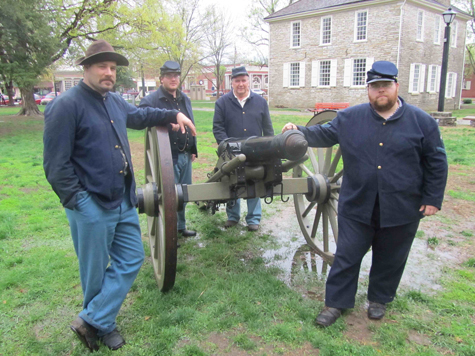 Reenactors of the 35th Ohio Volunteer Infantry Company
Reenactors of the 35th Ohio Volunteer Infantry Company
(l-r) Jason Hawley, Kevin Anderson, Bill Fuller, and Josh Moffett with puddles and a Model 1841 6-pounder Smooth Bore cannon in Corydon, Indiana, April 9, 2011.
Photo: Allen Bush
Bill Fuller a mechanical engineer from Sidney, Ohio was in Corydon, Indiana, on April 9th with twenty-one reenactors of the 35th Ohio Volunteer Infantry Company. Late Saturday morning, he sought shelter from hail and driving rain inside the old Indiana state capitol. Fuller has been standing at attention on weekends with his re-enactors for ten years. He enjoys educating school groups who come to see the Union Soldiers, but he also appreciates a few creature comforts, apart from the weekend battlefield. Staying dry is one of them. And lunch at the Real Enchilada, off the Corydon town square, better suits members of the regiment than “hard tack and salt pork.” One rebel reenactor, interviewed in Tony Horwitz’s Confederates in the Attic, sought a “time travel high” by soaking his buttons in urine and creating a perfect 1860s patina. “My wife woke-up, sniffed the air and said, ‘Tim you’re peeing on your buttons again.’” Fuller admits with a smile that he is not after a “period rush.”
Fuller, like many from the Ohio Volunteer Infantry reenactors, is a student of the Civil War. A bayonet, he explained, was a great foraging tool for potatoes and carrots. Fuller also told me soldiers occasionally gorged on fresh fruit and suffered the consequences of diarrhea – the “Old Soldiers Disease.”
Michael Shaara, in his novel The Killer Angels, describes the misfortune of the British tourist Arthur Fremantle who was traveling with the Confederates at Gettysburg. ”Freemantle felt a familiar rumble in his stomach. Oh God, not the soldiers disease. Those damned cherries…Soldiers [who] had observed him hanging in the air like a plump gray fruit were beginning to point and grin. Fremantle descended with dignity….”
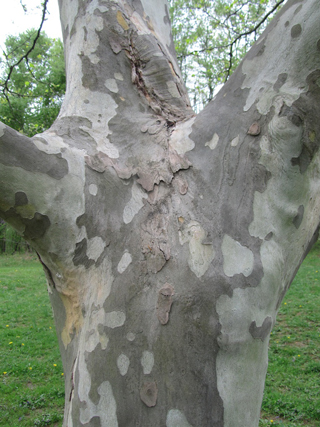 Platanus occidentalis: sycamore
Platanus occidentalis: sycamore
Photo: Allen Bush
There was no dignity the next afternoon on July 3, 1863. General Robert E. Lee badly miscalculated and ordered Pickett’s Charge. By day’s end 50,000 soldiers, from both sides, lay dead from the three-day battle. The Northern Army of Virginia went home.
Lee surrendered to Ulysses S. Grant on April 9, 1865 at Appomattox Courthouse, Virginia. 600,000 died during the Civil War that spanned four spring seasons. The Confederacy’s Secretary of State Robert Toombs had been right all along. “Legions now quiet will swarm out and sting us to death.”
Kentucky had chosen not to secede from the Union and tried to stay neutral, but the war took a toll. Joe Creason, Louisville Courier-Journal columnist, wrote about Kentuckians’ conflicted loyalties: “Those who fought were generally unable to agree why they fought. A sense of duty to family, loyalty to tradition, devotion to honor were intangible emotions shared by soldiers of the North and South alike. Both parts of the warring nation were sustained likewise by the same firm conviction that theirs, and only theirs, was a just cause in the sight of God.”
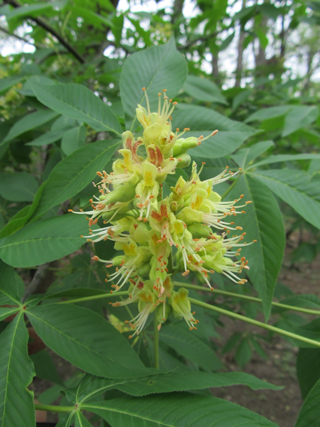 Aesculus flava
Aesculus flava
the yellow buckeye
Photo: Allen Bush
I drove south, in the afternoon for the semi-annual gala of automatic weapons with my brother-in-law, his teenage son and a friend. The Knob Creek Gun Range is little more than 20 miles from Louisville, down “Wide, Wide Dixie Highway.” Past Shively, Valley Station and a few miles beyond the cement plant at Kosmosdale, you’ll see a rusting sign on the right (“Dancers Wanted”) in front of the Rivergirls Lounge. Bullitt County is just ahead.
Take a sharp left onto Kentucky Hwy 44. Very soon, even if you’re stone cold deaf, and can’t hear the 50-caliber machine gun staccato thump, thump thump; you can’t miss the hundreds of cars, with license plates from as far away as Texas and New York, parked along both sides of the road. If you are paying any attention, you’ll see the chartreuse flowering tassels on sugar maples lighting-up the knobs. The crooked limbs on riverside sycamores can’t be camouflaged. You can sight these trees from long range, before leaves emerge, without the scope on a M1918 Browning automatic rifle. The cockscomb blooms on a lone yellow buckeye, halfway up the hill, would take a good marksman to spot. (Did anyone see any dogtooth violets, Trilliums or ramps?)
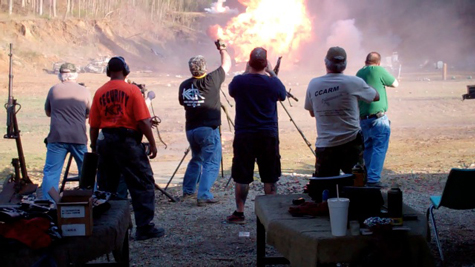
Gunning with new artillery at the Knob Creek gun Range, Bullitt (truly) County, Kentucky, 4/9/11
Photo: Allen Bush
Following prayers for fallen soldiers and the National Anthem, the spring sharpshooters began skirmishing with propane tanks, old refrigerators and jeeps on the anniversary of the Civil War surrender. Bombs bursting in air.
Comments
Thanks, Collis. Happy Derby Day! I don’t why they bothered calling the race the Run for the Roses. My few garden roses are bug eaten already. The Run for the Peonies suits this time of year a whole lot better.
Allen you would like Seeds by Richard Horan. There is a great section on some young trees now old – American sycamore, tulip poplar, etc. – at Gettysburg.
Georgia, I picked-up the book on your advice and have enjoyed reading this very much. Right-up my alley. Thanks very much


Raining bullets and beautiful flower petals…such an amazing image. Thank you cousin Allen for such a brilliant article! I am visiting with the Ardery family awaiting the opening of the peonies.
Collis Marshall